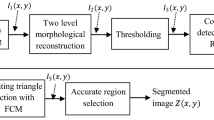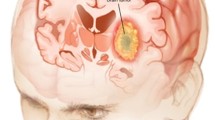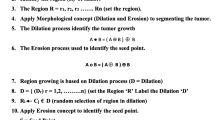Abstract
This paper proposes a novel brain tumor segmentation algorithm that uses Active Contour Model and Fuzzy-C-Means optimization. In Active Contour model, the initial Contour selection is a challenging task for MRI brain tumor segmentation because the accuracy of active contour segmentation depends on initial contour. This method uses the two level morphological reconstruction processes such as Dilation and Erosion along with thresholding process for minimizing the non-tumor region. The segmented region thus obtained is not accurate that also contains non-tumor region. Also there is a chance of missing the tumor region along with background while performing two level morphological reconstructions. In order to overcome these issues, active contour model is used to segment the complete tumor part. The initial Contour for Active Contour model is detected by forming a circular region around the tumor region. The radius of the circular region is contracted or expanded based on the shape of the tumor. This proposed Radius Contraction and Expansion (RCE) technique is used to select the initial contour of active Contour model. Further Fuzzy-C-Means algorithm is used to optimize the edge pixels because the boundary of active contour model output also contains the non tumor pixels. The performance of the proposed segmentation algorithm was evaluated using the metrics such as specificity, sensitivity, dice score, Probabilistic Rand Index (PRI) and Hausdorff Distance (HD) on T1- weighted contrast enhanced image dataset. The experimental result shows that the proposed segmentation algorithm provides a good performance when compared to the state-of-the-art segmentation methods.


















Similar content being viewed by others
References
Ain Q, Jaffar MA, Choi TS (2014) Fuzzy anisotropic diffusion based segmentation and texture based ensemble classification of brain tumor. Appl Soft Comput 21:330–340. https://doi.org/10.1016/j.asoc.2014.03.019
Andrew YN, Jordan, M, Yier, W 2001 et al., “ On spectral clustering: analysis and an algorithm”, Adv Neur In 2, 849–856
Angulakshmi, M., Lakshmi priya, G.G 2017 et al., “Automated Brain Tumor Segmentation Techniques—A Review”, Int J Imaging Syst Technol. 27, 66–77
Bahadure NB, Ray AK, Thethi HP (2017) Image analysis for MRI based brain tumor detection and feature extraction using biologically inspired BWT and SVM. Int. J. Biomed. Imaging 2017:1–12. https://doi.org/10.1155/2017/9749108
Bauer, S Et al. 2011, “Fully automatic segmentation of brain tu- mor images using support vector machine classification in combination with hierarchical conditional random field regularization” , In: MICCAI, Vol. 6893, pp. 354–361
Bauer S et al (2013) A survey of mri-based medical image analysis for brain tumor studies. Phys Med Biol 58:97–129
Bengio, Y , Courville, A 2013, et al ,“Representation learning: a review and new perspectives” Pattern Anal Mach Intell IEEE Trans 35, 1798–1828
Bengio, Y et al. 2012, “Practical recommendations for gradient-based training of deep ar- chitectures in: neural networks”, Tricks of the Trade Springer, pp. 437–478
Cabria, I., Gondra, I 2017 et al., “MRI segmentation fusion for brain tumor detection”. Information Fusion 36, 1–9
Cheng, J.u.n. (2017) Brain Tumor Dataset. https://figshare.com/articles/brain_tumor_dataset/1512427, 5, https://figshare.com/articles/brain_tumor_dataset/1512427
Ciresan, D, Giusti, A , Gambardella 2012 et al., “ Deep neural net- works segment neuronal membranes in electron microscopy images”, Ad- vances in Neural Information Processing Systems, pp. 2843–2851
Clark, M , Hall, L , Goldgof, D , Velthuizen, RP 1998 et al, “Automatic tumor segmentation using knowledge-based clustering”, IEEE Trans Med Imag 17, 187–201
Dass R, Priyanka, Devi S (2012) Image segmentation techniques. International Journal of Electronics & Communication Technology (IJECT) 3(1):2230–7109
Elyasi A et al (2011) Active contours in Brain tumor segmentation. Journal of American Science 7(7)
G. Evelin Sujji, YVS. Lakshmi and G. Wiselin Jiji 2013, “MRI Brain Image Segmentation based on Thresholding”, International Journal of Advanced Computer Research, vol. 3, no. 1, issue 8, pp. 2249–7277
Havaei M, Davy A, Warde-Farley D, Biard A, Courville A, Bengio Y, Pal C, Jodoin PM, Larochelle H (2017) Brain tumor segmentation with deep neural networks. Med Image Anal 35:18–31
Hu K, Gan Q, Zhang Y, Deng S, Xiao F, Huang W, Cao C, Gao X (2019) Brain tumor segmentation using multi-cascaded convolutional neural networks and conditional random field. IEEE Access 7:92615–92629. https://doi.org/10.1109/ACCESS.2019.2927433
Umit Ilhan, Ahmet Ilhan 2017 et al “brain tumor segmentation based on a new threshold approach” international conference on theory and application of soft computing, Prog. Comput. Sci. 120, 580–587
E. Ilunga-Mbuyamba, JG. Avina-Cervantes 2017 et al, “Localized active contour model with background intensity compensation applied on automatic MR brain tumor segmentation”, Neurocomputing 220, 84–97
Jeetashree, A, PradiptaKumar, N, Niva 2016 et al., “Modified possibilistic fuzzy C-means algorithms for segmentation of magnetic resonance image”, Appl Soft Comput. 41, 104–119
Li J, Yu ZL, Gu Z, Li Y (2019) MMAN: multi-modality aggregation network for brain segmentation from MR images. Neurocomputing. 358:10–19. https://doi.org/10.1016/j.neucom.2019.05.025
Liang, Z. , Wei, W., Jason, JC 2012 et al, “Brain tumor segmentation based on GMM and active contour method with a model-aware edge map”, Proceedings of MICCAI BRATS 24–2
S. Morales, A. Bernabeu-Sanz, F. Lopez-Mir 2017 et al., “BRAIM: a computer-aided diagnosis system for neurodegenerative diseases and brain lesion monitoring from volumetric analyses”, Comput Methods Prog Biomed 145, 167, 179.
Naceur MB, Saouli R, Akil M, Kachouri R (2018) Fully automatic brain tumor segmentation using end-to-end incremental deep neural networks in MRI images. Comput. Methods Prog. Biomed 166:39–49. https://doi.org/10.1016/j.cmpb.2018.09.007
P. Patil, KS. Kumar, N. Gaud and VB. Semwal 2019, “Clinical Human Gait Classification: Extreme Learning Machine Approach," 1st international conference on advances in science, engineering and robotics technology (ICASERT), Dhaka 2019, pp. 1–6.
Selvaraj D et al (2013) MRI brain image segmentation techniques - a review. Indian Journal of Computer Science and Engineering (IJCSE) 4(5):0976–5166
Semwal VB, Raj M, Nandi GC (2015) Biometric gait identification based on a multilayer perceptron. Robot Auton Syst 65:65–75. https://doi.org/10.1016/j.robot.2014.11.010
Semwal VB, Mondal K, Nandi GC (2017) Robust and accurate feature selection for humanoid push recovery and classification: deep learning approach. Neural Comput. & Applic. 28:565–574. https://doi.org/10.1007/s00521-015-2089-3
Semwal, VB., Singha, J., Sharma, P. (2017) et al. An optimized feature selection technique based on incremental feature analysis for bio-metric gait data classification. Multimed Tools Appl 76, 24457–24475 https://doi.org/10.1007/s11042-016-4110-y
Semwal VB, Kumar C, Mishra PK, Nandi GC (2018) Design of Vector Field for different subphases of gait and regeneration of gait pattern. in IEEE Trans. Autom. Sci. Eng. 15(1):104–110
Semwal VB, Gaud N, Nandi GC (2019) Human gait state prediction using cellular automata and classification using ELM. In: Tanveer M, Pachori R (eds) machine intelligence and signal analysis. Advances in intelligent systems and computing, vol 748. Springer, Singapore
Sheela CJJ, Suganthi G (2019) Automatic Brain Tumor Segmentation from MRI using Greedy Snake Model and Fuzzy C-means Optimization. Journal of King Saud University -Computer and Information Sciences
Tarkhaneh O, Shen H (2019) An adaptive differential evolution algorithm to optimal multi-level Thresholding for MRI brain image segmentation. Expert Syst Appl 138:112820. https://doi.org/10.1016/j.eswa.2019.07.037
Thaha MM, Kumar KPM, Murugan BS, Dhanasekeran S, Vijayakarthick P, Selvi AS (2019) Brain tumor segmentation using convolutional neural networks in MRI images. J Med Syst 43:294. https://doi.org/10.1007/s10916-019-1416-0
Tuhin, UP, Samir, KB 2012 et al., “Segmentation of Brain Tumor from Brain MRI Images. Reintroducing K–Means with advanced Dual Localization Method”, Int J Eng Res Appl. 2 (3), 226–231
Vijay V, Kavitha AR, Rebecca SR (2016) Automated brain tumor segmentation and detection in MRI using enhanced Darwinian particle swarm optimization(EDPSO). Prog. Comput. Sci. 92:475–480. https://doi.org/10.1016/j.procs.2016.07.370
Viji KA, JayaKumari J (2013) Modified texture based region growing segmentation of MR brain images. In: Information & Communication Technologies (ICT), IEEE Conference on, pp. 691–695. IEEE
Guotai Wang, Wenqi Li, Maria A. Zuluaga 2018 et al., “Interactive medical image segmentation using deep learning with image-specific fine-tuning”, IEEE Transactions on Medical Imaging, Interactive Medical Image Segmentation Using Deep Learning With Image-Specific Fine Tuning.
Zhang W, Li R, Deng H, Wang L, Lin W, Ji S, Shen D (2015) Deep convolutional neural networks for multi-modality isointense infant brain image segmentation. NeuroImage 108:214–224. https://doi.org/10.1016/j.neuroimage.2014.12.061
Zhao X, Wu Y, Song G, Li Z, Zhang Y, Fan Y (2018) A deep learning model integrating FCNNs and CRFs for brain tumor segmentation. Med Image Anal 43:98–111. https://doi.org/10.1016/j.media.2017.10.002
Author information
Authors and Affiliations
Corresponding author
Additional information
Publisher’s note
Springer Nature remains neutral with regard to jurisdictional claims in published maps and institutional affiliations.
Rights and permissions
About this article
Cite this article
Sheela, C.J.J., Suganthi, G. Brain tumor segmentation with radius contraction and expansion based initial contour detection for active contour model. Multimed Tools Appl 79, 23793–23819 (2020). https://doi.org/10.1007/s11042-020-09006-1
Received:
Revised:
Accepted:
Published:
Issue Date:
DOI: https://doi.org/10.1007/s11042-020-09006-1




